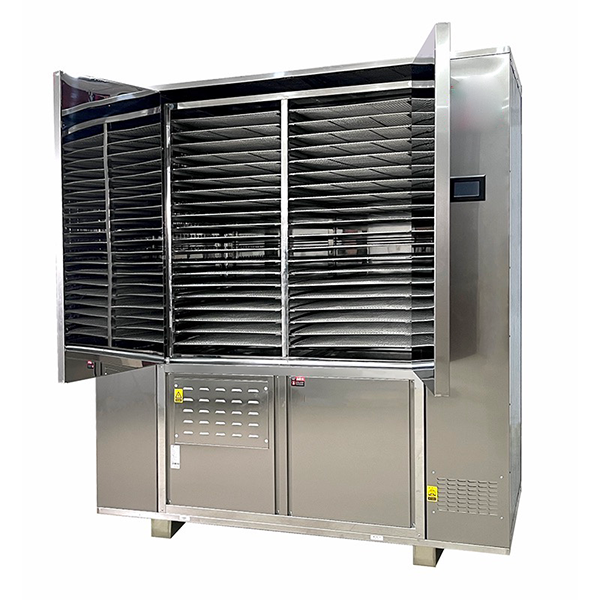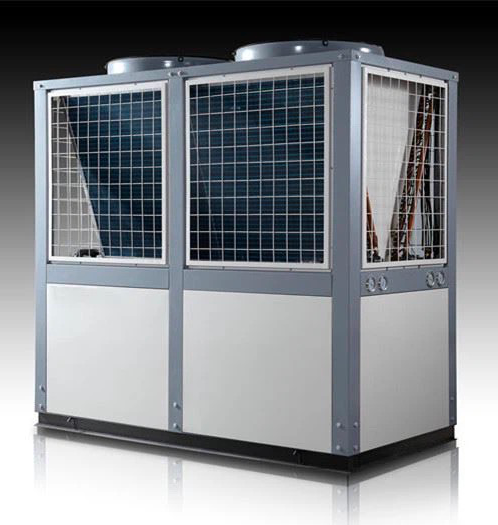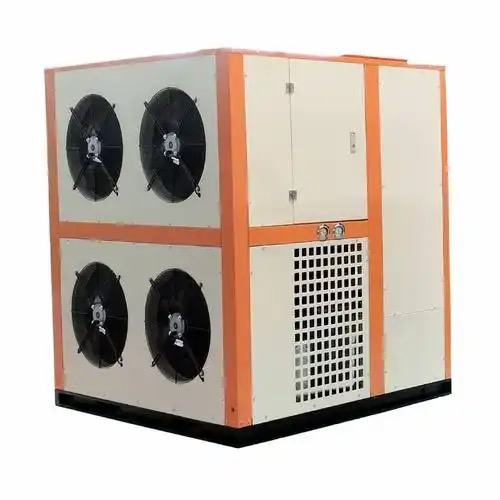
Content Menu
● Understanding Heat Pump Dryers
● Advantages of New Heat Pump Dryers
● How New Heat Pump Dryers Work
● Applications in Food Processing
● Innovations in Heat Pump Drying Technology
● Environmental Impact
● Case Studies
● Future Trends in Heat Pump Drying Technology
● Expanding on Applications: Specific Food Types
>> Fruits
>>> Example: Apple Drying Process
>> Vegetables
>>> Example: Carrot Drying Process
>> Herbs
>>> Example: Basil Drying Process
>> Meats
>>> Example: Jerky Production Process
● Conclusion
● Frequently Asked Questions
>> 1. What is a heat pump dryer?
>> 2. How does a heat pump dryer save energy?
>> 3. Can heat pump dryers be used for all types of foods?
>> 4. What are the benefits of low-temperature drying?
>> 5. Are there any downsides to using heat pump dryers?
In the food processing industry, drying is a crucial step that significantly affects the quality, shelf life, and marketability of food products. Among various drying technologies, new heat pump dryers have emerged as a revolutionary solution. This article delves into the advantages of new heat pump dryers over traditional drying methods, particularly in the context of food drying.

Understanding Heat Pump Dryers
Heat pump dryers operate on the principle of transferring heat from one place to another, utilizing a refrigeration cycle that can be reversed. This technology allows for efficient drying at lower temperatures, which is particularly beneficial for heat-sensitive food products. The system comprises several components, including a compressor, evaporator, condenser, and expansion valve, all working together to achieve optimal drying conditions.
Advantages of New Heat Pump Dryers
1. Energy Efficiency
One of the most significant benefits of new heat pump dryers is their energy efficiency. These dryers can reduce energy consumption by up to 60-80% compared to conventional dryers. This is achieved through the recirculation of air and the recovery of latent heat during the drying process. The ability to operate at lower temperatures also contributes to energy savings while ensuring effective moisture removal.
2. Preservation of Nutritional Quality
New heat pump dryers excel in preserving the nutritional quality of food products. By operating at lower temperatures, they minimize the degradation of vitamins and other sensitive compounds that are often lost in traditional high-temperature drying methods. This results in higher-quality dried foods that retain their flavor, color, and nutritional value.
3. Controlled Drying Environment
Heat pump dryers provide a controllable drying environment where temperature and humidity levels can be precisely adjusted. This feature allows for tailored drying processes that suit different types of food products, ensuring uniform drying and preventing issues such as over-drying or under-drying.
4. Versatility in Applications
These dryers are versatile and can be used for a wide range of food products, including fruits, vegetables, herbs, and even meats. The ability to adjust drying parameters makes them suitable for various materials with different moisture content and sensitivity to heat.
5. Reduced Operating Costs
Although the initial investment in new heat pump dryer technology may be higher than traditional systems, the long-term savings on energy bills and maintenance costs make them economically advantageous. Their durability and efficiency lead to lower operational costs over time.
How New Heat Pump Dryers Work
The operation of a new heat pump dryer involves several stages:
1. Air Intake: Ambient air is drawn into the dryer.
2. Heating: The air passes over the evaporator coil where it absorbs moisture from the food.
3. Condensation: Moist air is then cooled in the condenser where moisture condenses into water.
4. Recirculation: The dried air is reheated and recirculated back into the drying chamber.
This continuous cycle ensures efficient moisture removal while maintaining optimal conditions for food preservation.

Applications in Food Processing
Heat pump dryers are increasingly being adopted in various sectors of the food industry due to their numerous advantages:
- Fruits: Apples, bananas, and berries can be dried without losing their vibrant colors or nutrients.
- Vegetables: Leafy greens and root vegetables retain their texture and flavor when dried using this technology.
- Herbs: Delicate herbs maintain their essential oils and aromas during the drying process.
- Meats: Low-temperature drying preserves meat quality while extending shelf life.
Innovations in Heat Pump Drying Technology
Recent advancements in heat pump technology have further enhanced its application in food processing:
- Hybrid Systems: Combining heat pumps with other technologies such as solar or microwave-assisted drying can optimize energy use and improve efficiency.
- Smart Controls: Modern heat pump dryers are equipped with smart sensors that monitor humidity and temperature in real-time, allowing for automatic adjustments to ensure optimal drying conditions.
- Modular Designs: New modular designs allow for scalability in production facilities, enabling businesses to expand their operations without significant additional investments.
Environmental Impact
The environmental benefits of using new heat pump dryers cannot be overstated. By significantly reducing energy consumption compared to traditional methods, these systems contribute to lower greenhouse gas emissions. Furthermore, their ability to operate efficiently with renewable energy sources aligns with global sustainability goals.
Case Studies
Several companies have successfully implemented new heat pump dryer technology with remarkable results:
- Good to Go: Located in Maine and specializing in ready-to-eat meals, Good to Go has reported a fourfold increase in production capacity after switching to Nyle Systems' FD60 Heat Pump Dehydrator while simultaneously cutting electric consumption by over 50%.
- Local Farms: Many local farms have adopted heat pump dryers for processing fruits and vegetables, resulting in higher product quality and extended shelf life due to better preservation of nutrients.
Future Trends in Heat Pump Drying Technology
As technology advances further within this field:
1. Integration with IoT Devices: Future models may incorporate Internet-of-Things (IoT) capabilities enabling real-time monitoring via mobile apps or web interfaces allowing operators instant access data analytics regarding performance metrics such as energy consumption rates against output quality measures etc., facilitating proactive decision-making strategies aimed towards optimizing production efficiency levels continuously over time!
2. Sustainability Initiatives: With growing concerns about climate change impacting global agriculture practices—heat pumps will likely play an increasingly vital role within sustainable farming initiatives aimed at reducing carbon footprints associated with conventional agricultural practices through improved resource management techniques deployed across entire supply chains from farm-to-table scenarios!
3. Research & Development Investments: Ongoing investments into R&D efforts focused on enhancing existing designs further could yield breakthroughs leading towards even more efficient models capable not only reducing operational costs but also maximizing overall throughput capabilities thereby supporting larger-scale operations across diverse sectors within food processing industries worldwide.
Expanding on Applications: Specific Food Types
Fruits
Fruits are one of the most popular categories processed using new heat pump dryers. They require careful handling during dehydration as high temperatures can lead to loss of flavor and nutrients. Heat pump technology allows processors to dry fruits like apples or strawberries at lower temperatures while still achieving effective moisture removal.
Example: Apple Drying Process
When apples are dried using traditional methods at high temperatures (around 70°C), they tend to lose much of their vitamin C content along with flavor compounds that contribute to their taste profile. In contrast, when using a new heat pump dryer set at around 50°C or lower:
- Nutritional retention increases significantly.
- The dried apples maintain their vibrant color.
- Flavor profiles remain intact due to minimal thermal degradation.
This method not only enhances product quality but also appeals more strongly to health-conscious consumers looking for nutritious snacks.
Vegetables
Vegetables like carrots or bell peppers also benefit from being dried with new heat pump technology:
- Color Retention: Bright colors are preserved due to low-temperature processes.
- Flavor Preservation: Essential oils that contribute flavor remain intact.
- Texture Maintenance: The controlled environment prevents mushiness often associated with rapid dehydration techniques.
Example: Carrot Drying Process
Carrots dried at high temperatures often lose their crispness; however:
- Using a new heat pump dryer allows for gradual moisture extraction at lower temperatures.
- This results in crispy dried carrot slices that retain both texture and flavor integrity—ideal for snacks or culinary uses.
Herbs
Herbs such as basil or oregano are delicate; thus they require gentle handling during dehydration:
- New heat pumps provide precise control over humidity levels which prevents browning or loss of essential oils.
- Dried herbs retain stronger flavors compared to those processed under harsher conditions found in conventional systems.
Example: Basil Drying Process
When basil leaves are dried using traditional methods:
- They often turn brown due to excessive heat exposure.
Using a new heat pump dryer minimizes this risk by allowing operators:
- To set specific humidity levels that prevent browning while ensuring thorough moisture removal.
This results in vibrant green dried basil—much sought after by culinary professionals who value quality ingredients.
Meats
For meat products like jerky or dehydrated sausages:
- Low-temperature drying prevents fat oxidation which can lead to rancidity.
- Controlled environments allow for even cooking while removing moisture effectively without compromising texture or taste.
Example: Jerky Production Process
Traditional jerky production often involves high-temperature cooking which can toughen meat fibers:
- A new heat pump dryer operates at lower temperatures (around 50°C), allowing collagen breakdown without excessive cooking.
This results in tender jerky that retains its natural flavors—an appealing product for consumers seeking healthy protein snacks without additives or preservatives.
Conclusion
The advent of new heat pump dryer technology marks a significant advancement in food processing methods. With their energy efficiency, ability to preserve nutritional quality, controlled environment, versatility, and reduced operating costs, they offer substantial benefits over traditional drying methods. As more food manufacturers recognize these advantages, it is likely that heat pump dryers will become a standard in food processing facilities worldwide.

Frequently Asked Questions
1. What is a heat pump dryer?
A heat pump dryer is an advanced drying system that utilizes a refrigeration cycle to transfer heat efficiently for drying various materials at controlled temperatures and humidity levels.
2. How does a heat pump dryer save energy?
Heat pump dryers save energy by recirculating heated air within the system and recovering latent heat from moisture removed during drying, resulting in significantly lower energy consumption compared to traditional dryers.
3. Can heat pump dryers be used for all types of foods?
Yes, heat pump dryers are versatile and can be used for a wide range of foods including fruits, vegetables, herbs, and meats due to their ability to control temperature and humidity levels precisely.
4. What are the benefits of low-temperature drying?
Low-temperature drying helps preserve the nutritional quality of food by preventing degradation of sensitive compounds such as vitamins while maintaining flavor and color integrity.
5. Are there any downsides to using heat pump dryers?
While there may be higher initial costs associated with purchasing a heat pump dryer compared to conventional systems, the long-term savings on energy bills and maintenance typically outweigh these initial expenses.












